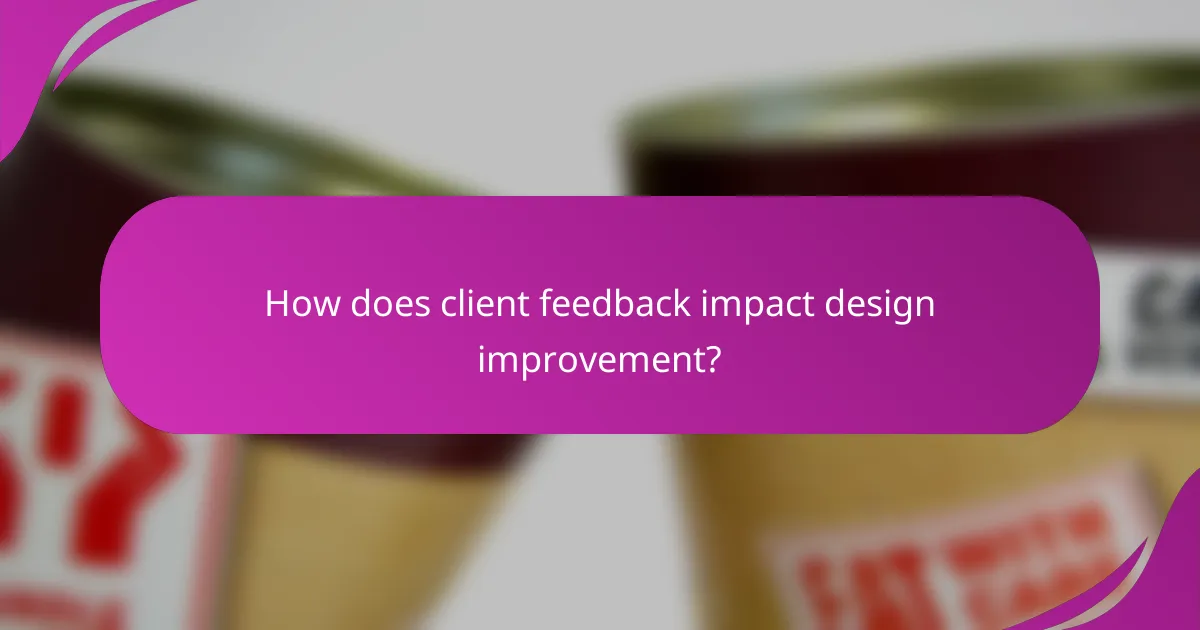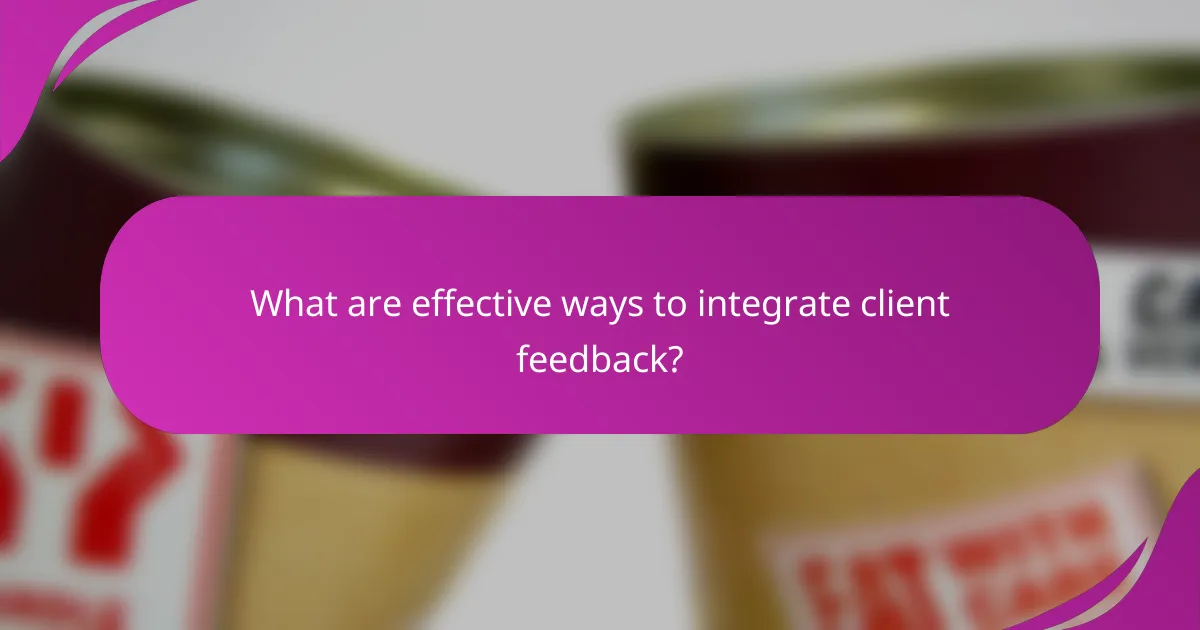Client feedback plays a crucial role in driving design improvements by offering valuable insights into user needs and preferences. By effectively integrating this feedback through systematic collection and analysis, designers can make informed adjustments that enhance product effectiveness and overall satisfaction.

How does client feedback impact design improvement?
Client feedback significantly influences design improvement by providing insights into user needs and preferences. This information helps designers make informed adjustments that enhance overall product effectiveness and satisfaction.
Enhances user experience
Incorporating client feedback directly enhances user experience by aligning product features with user expectations. For instance, if users express difficulty navigating a website, designers can simplify the layout or improve navigation tools.
Regularly collecting feedback through surveys or usability tests allows teams to identify pain points and prioritize enhancements. This iterative approach ensures that the design evolves in a way that genuinely meets user needs.
Informs product iterations
Client feedback serves as a critical resource for informing product iterations, guiding teams on what changes to implement in future versions. By analyzing feedback trends, designers can pinpoint which features are valued and which require rethinking.
For example, if a mobile app receives consistent feedback about slow loading times, developers can prioritize performance improvements in the next update. This data-driven approach fosters continuous improvement and innovation.
Builds customer loyalty
Actively integrating client feedback into design processes builds customer loyalty by demonstrating that their opinions are valued. When users see their suggestions reflected in product updates, they feel a stronger connection to the brand.
Moreover, fostering an open dialogue through feedback channels encourages customers to engage more frequently, leading to a community of loyal users who advocate for the product. This loyalty can translate into long-term business success and increased customer retention rates.

What are effective ways to integrate client feedback?
Effective integration of client feedback involves systematically collecting, analyzing, and applying insights to improve products or services. Utilizing various methods ensures a comprehensive understanding of client needs and preferences.
Surveys and questionnaires
Surveys and questionnaires are straightforward tools for gathering client feedback. They can be distributed online or in-person and should include a mix of quantitative and qualitative questions to capture detailed insights.
Consider using Likert scales for rating satisfaction and open-ended questions for deeper insights. Aim for a completion time of 5-10 minutes to encourage higher response rates.
To maximize effectiveness, target specific client segments and ensure anonymity to promote honest feedback.
User testing sessions
User testing sessions provide direct observation of clients interacting with your product or service. This method allows you to identify usability issues and gather immediate feedback on features and design.
Sessions can be conducted in-person or remotely, lasting anywhere from 30 minutes to a few hours. Prepare specific tasks for users to complete, and encourage them to verbalize their thoughts during the process.
Record sessions for later analysis, and consider offering incentives to participants to enhance engagement.
Feedback management tools
Feedback management tools help streamline the collection and analysis of client feedback. These platforms can centralize responses from various sources, making it easier to identify trends and prioritize improvements.
Popular tools include platforms like SurveyMonkey, Typeform, and UserTesting, which offer features for real-time analytics and reporting. Choose a tool that fits your budget and integrates well with your existing systems.
Regularly review the data collected and share insights with relevant teams to ensure that client feedback informs decision-making processes.

What are best practices for collecting client feedback in Canada?
Best practices for collecting client feedback in Canada involve using a mix of digital and personal approaches to gather insights effectively. This ensures a comprehensive understanding of client needs and preferences, leading to improved services and products.
Utilizing online platforms
Online platforms are essential for collecting client feedback efficiently. Tools like SurveyMonkey, Google Forms, and Typeform allow businesses to create surveys that can be distributed via email or social media, reaching a broad audience quickly.
When using online platforms, keep surveys short and focused, ideally taking no more than 5-10 minutes to complete. Offering incentives, such as discounts or entry into a prize draw, can increase response rates significantly.
In-person interviews
In-person interviews provide a deeper understanding of client feedback through direct interaction. This method allows for nuanced discussions and the opportunity to clarify responses on the spot.
To conduct effective interviews, prepare open-ended questions that encourage detailed responses. Aim for a comfortable setting and consider recording the conversation (with permission) to capture insights accurately.
Social media engagement
Social media is a powerful tool for gathering client feedback in real-time. Platforms like Facebook, Twitter, and Instagram enable businesses to engage with clients directly, asking for their opinions on products or services.
Monitor comments and messages actively, and consider using polls or questions in posts to solicit feedback. Responding promptly to client interactions can foster a sense of community and encourage more clients to share their thoughts.

How can businesses analyze client feedback?
Businesses can analyze client feedback by employing various methods to extract meaningful insights that drive improvement. This involves systematically collecting, categorizing, and interpreting client responses to enhance products, services, and overall customer satisfaction.
Thematic analysis
Thematic analysis is a qualitative method that identifies patterns or themes within client feedback. By reviewing comments and suggestions, businesses can categorize responses into key themes that highlight common issues or areas for improvement.
To conduct thematic analysis, start by gathering a representative sample of feedback. Then, read through the responses to identify recurring topics, grouping similar comments together. This approach can reveal insights that quantitative data might overlook.
Sentiment analysis tools
Sentiment analysis tools use natural language processing to evaluate the emotional tone of client feedback. These tools can automatically classify comments as positive, negative, or neutral, providing a quick overview of customer sentiment.
When selecting sentiment analysis tools, consider their accuracy and ability to handle industry-specific language. Popular options include software like MonkeyLearn and Lexalytics, which can process large volumes of feedback efficiently, allowing businesses to respond proactively to client concerns.
Data visualization techniques
Data visualization techniques help businesses present client feedback in an easily digestible format. By using charts, graphs, and dashboards, organizations can visualize trends and patterns in customer responses, making it easier to identify areas needing attention.
Common visualization methods include bar charts for comparing feedback categories and line graphs for tracking sentiment over time. Tools like Tableau and Google Data Studio can assist in creating these visualizations, enabling stakeholders to make informed decisions based on client feedback data.

What frameworks help in prioritizing client feedback?
Several frameworks assist organizations in prioritizing client feedback effectively. These methods provide structured approaches to evaluate and rank feedback based on various criteria, ensuring that the most impactful insights are addressed first.
MoSCoW method
The MoSCoW method categorizes feedback into four distinct groups: Must have, Should have, Could have, and Won’t have. This prioritization helps teams focus on essential features or improvements that directly impact client satisfaction.
To implement this method, gather all client feedback and classify each item accordingly. For example, a “Must have” feature might be a critical bug fix, while a “Could have” suggestion could be a nice-to-have enhancement that can wait. This clarity aids in resource allocation and project planning.
RICE scoring model
The RICE scoring model evaluates feedback based on Reach, Impact, Confidence, and Effort. Each item receives a score that helps teams prioritize initiatives that maximize client value while considering the resources required.
To use RICE, assign a numerical value to each category. For instance, if a feature is expected to reach hundreds of clients (high Reach), significantly improve their experience (high Impact), is backed by solid data (high Confidence), but requires substantial development time (high Effort), you can calculate its overall score. This method allows for a balanced view of potential improvements.


